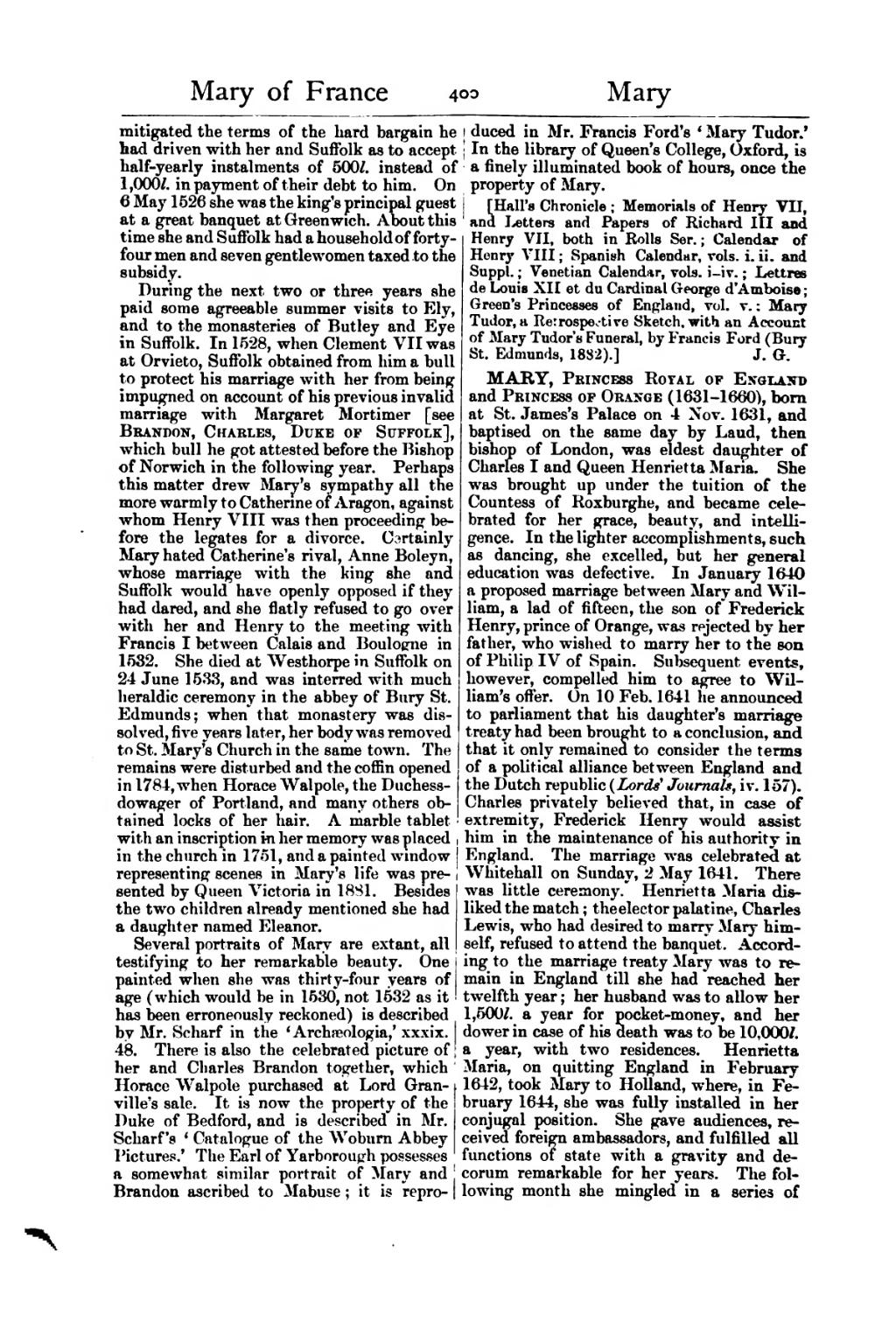mitigated the terms of the hard bargain he had driven with her and Suffolk as to accept half-yearly instalments of 500l. instead of 1,000l. in payment of their debt to him. On 6 May 1526 she was the king's principal guest at a great banquet at Greenwich. About this time she and Suffolk had a household of forty-four men and seven gentlewomen taxed to the subsidy.
During the next two or three years she paid some agreeable summer visits to Ely, and to the monasteries of Butley and Eye in Suffolk. In 1528, when Clement VII was at Orvieto, Suffolk obtained from him a bull to protect his marriage with her from being impugned on account of his previous invalid marriage with Margaret Mortimer [Brandon, Charles, Duke of Suffolk], which bull he got attested before the Bishop of Norwich in the following year. Perhaps this matter drew Mary's sympathy all the more warmly to Catherine of Aragon, against whom Henry VIII was then proceeding before the legates for a divorce. Certainly Mary hated Catherine's rival, Anne Boleyn, whose marriage with the king she and Suffolk would have openly opposed if they had dared, and she flatly refused to go over with her and Henry to the meeting with Francis I between Calais and Boulogne in 1532. She died at Westhorpe in Suffolk on 24 June 1533, and was interred with much heraldic ceremony in the abbey of Bury St. Edmunds; when that monastery was dissolved, five years later, her body was removed to St. Mary's Church in the same town. The remains were disturbed and the coffin opened in 1784, when Horace Walpole, the Duchess-dowager of Portland, and many others obtained locks of her hair. A marble tablet with an inscription in her memory was placed in the church in 1751, and a painted window representing scenes in Mary's life was presented by Queen Victoria in 1881. Besides the two children already mentioned she had a daughter named Eleanor.
Several portraits of Mary are extant, all testifying to her remarkable beauty. One painted when she was thirty-four years of age (which would be in 1530, not 1532 as it has been erroneously reckoned) is described by Mr. Scharf in the ‘Archæologia,’ xxxix. 48. There is also the celebrated picture of her and Charles Brandon together, which Horace Walpole purchased at Lord Granville's sale. It is now the property of the Duke of Bedford, and is described in Mr. Scharf's ‘Catalogue of the Woburn Abbey Pictures.’ The Earl of Yarborough possesses a somewhat similar portrait of Mary and Brandon ascribed to Mabuse; it is reproduced in Mr. Francis Ford's ‘Mary Tudor.’ In the library of Queen's College, Oxford, is a finely illuminated book of hours, once the property of Mary.
[Hall's Chronicle; Memorials of Henry VII, and Letters and Papers of Richard III and Henry VII, both in Rolls Ser.; Calendar of Henry VIII; Spanish Calendar, vols. i. ii. and Suppl.; Venetian Calendar, vols. i–iv.; Lettres de Louis XII et du Cardinal George d'Amboise; Green's Princesses of England, vol. v.; Mary Tudor, a Retrospective Sketch, with an Account of Mary Tudor's Funeral, by Francis Ford (Bury St. Edmunds, 1882).]
MARY, Princess Royal of England and Princess of Orange (1631–1660), born at St. James's Palace on 4 Nov. 1631, and baptised on the same day by Laud, then bishop of London, was eldest daughter of Charles I and Queen Henrietta Maria. She was brought up under the tuition of the Countess of Roxburghe, and became celebrated for her grace, beauty, and intelligence. In the lighter accomplishments, such as dancing, she excelled, but her general education was defective. In January 1640 a proposed marriage between Mary and William, a lad of fifteen, the son of Frederick Henry, prince of Orange, was rejected by her father, who wished to marry her to the son of Philip IV of Spain. Subsequent events, however, compelled him to agree to William's offer. On 10 Feb. 1641 he announced to parliament that his daughter's marriage treaty had been brought to a conclusion, and that it only remained to consider the terms of a political alliance between England and the Dutch republic (Lords' Journals, iv. 157). Charles privately believed that, in case of extremity, Frederick Henry would assist him in the maintenance of his authority in England. The marriage was celebrated at Whitehall on Sunday, 2 May 1641. There was little ceremony. Henrietta Maria disliked the match; the elector palatine, Charles Lewis, who had desired to marry Mary himself, refused to attend the banquet. According to the marriage treaty Mary was to remain in England till she had reached her twelfth year; her husband was to allow her 1,500l. a year for pocket-money, and her dower in case of his death was to be 10,000l. a year, with two residences. Henrietta Maria, on quitting England in February 1642, took Mary to Holland, where, in February 1644, she was fully installed in her conjugal position. She gave audiences, received foreign ambassadors, and fulfilled all functions of state with a gravity and decorum remarkable for her years. The following month she mingled in a series of
